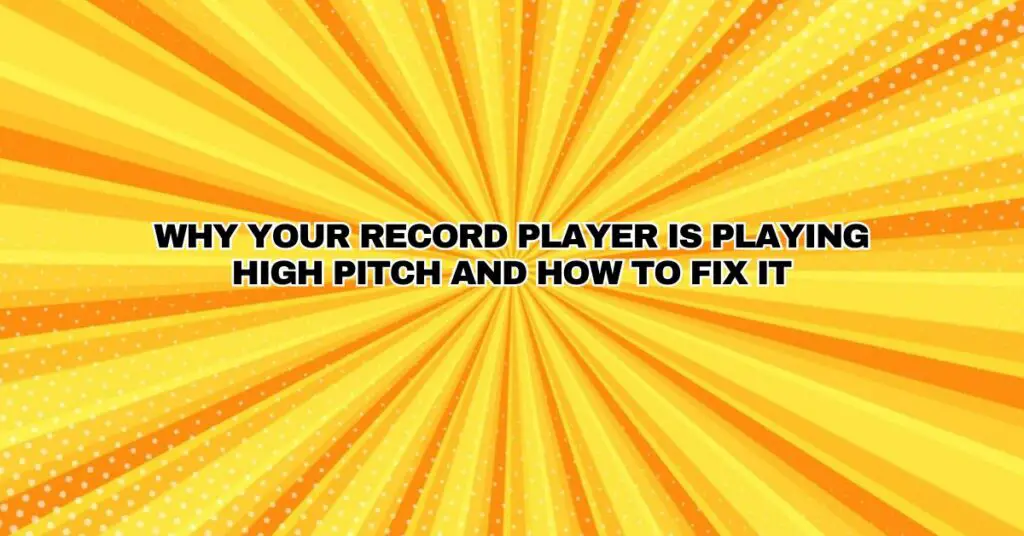Vinyl records, renowned for their analog warmth and nostalgic charm, have experienced a resurgence in popularity, drawing audiophiles and music enthusiasts back to the realm of analog sound. However, one of the most distressing issues that can plague your vinyl listening experience is when the record player starts playing records at a higher pitch than they should be. This high-pitched playback not only distorts the sound but also disrupts the intended listening experience. In this comprehensive guide, we’ll explore the common causes of high-pitched playback on a record player and provide practical solutions to help you rectify this issue and savor your vinyl collection as it was meant to be heard.
Understanding the Basics of Record Player Operation
Before we delve into the reasons behind high-pitched playback and how to fix it, it’s essential to have a fundamental understanding of the components and their roles in a typical record player setup:
- Platter: The rotating platform where the vinyl record sits during playback.
- Tonearm: The arm that holds the cartridge and stylus (needle), which traces the grooves on the record.
- Cartridge and Stylus: The cartridge converts the mechanical vibrations of the stylus into electrical signals, which are then amplified to produce sound.
- Turntable Motor: Responsible for spinning the platter at the specified speed, determining the playback rate (e.g., 33⅓ or 45 RPM).
- Drive System: Record players can be belt-driven or direct-drive, each with unique characteristics affecting pitch stability.
Common Causes of High-Pitched Playback
Several factors can contribute to high-pitched playback on a record player, causing it to play records at a faster speed than intended. Understanding these causes is crucial in diagnosing the issue accurately. Here are the most common reasons behind high-pitched playback:
- Incorrect Speed Setting:
- An incorrect speed setting on the turntable can lead to high-pitched playback. If the turntable is set to the wrong RPM (e.g., 45 RPM instead of 33⅓), it will result in faster playback.
- Belt Issues (Belt-Driven Turntables):
- In belt-driven turntables, the belt connecting the motor to the platter may become loose, stretched, or damaged, causing speed inconsistencies and high-pitched playback.
- Motor Problems:
- Direct-drive turntables have a motor that directly connects to the platter. If the motor experiences issues or malfunctions, it can lead to fluctuations in speed and high-pitched playback.
- Cartridge and Stylus Issues:
- A misaligned or damaged cartridge or stylus can affect the playback quality, leading to high-pitched playback.
Solutions to Fix High-Pitched Playback
To correct high-pitched playback on your record player and ensure it plays your vinyl records at the correct pitch, consider the following solutions:
- Speed Calibration:
- Verify that your turntable is set to the correct speed for the type of record you are playing (e.g., 33⅓ RPM for LPs and 45 RPM for singles). Use the turntable’s speed adjustment controls if necessary.
- Belt-Driven Turntables:
- Inspect the condition of the belt and ensure it is correctly seated on the motor pulley and the platter’s sub-platter. If the belt is worn or damaged, replace it.
- Motor Problems (Direct-Drive Turntables):
- If your direct-drive turntable exhibits motor issues or malfunctions, consult the manufacturer or a qualified technician for a diagnosis and potential repairs.
- Cartridge and Stylus Maintenance:
- Check the cartridge alignment and ensure that the stylus is clean and in good condition. If the cartridge or stylus is worn or damaged, consider replacing them.
Preventive Measures for Maintaining Pitch Accuracy
To prevent future occurrences of high-pitched playback on your record player and maintain the accurate playback of your vinyl records, consider the following preventive measures:
- Regularly maintain and calibrate your turntable’s settings to ensure they are aligned and optimized.
- Store your vinyl records vertically and in protective sleeves to maintain their condition and prevent dust buildup.
- Handle your records with care, avoiding direct contact with the grooves to keep them free from fingerprints and smudges.
- Invest in high-quality accessories such as stylus cleaning kits and anti-static brushes to ensure your vinyl collection and equipment remain in optimal condition.
By addressing the causes of high-pitched playback and adopting preventive measures, you can enjoy your vinyl records as intended – with the warm, authentic sound and tactile charm that makes vinyl so beloved by music enthusiasts.

